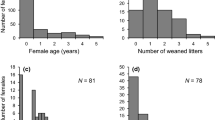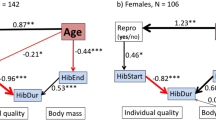Abstract
The timing of reproduction is one of the most crucial life history traits, with enormous consequences for the fitness of an individual. We investigated the effects of season and timing of birth on local survival probability in a small mammalian hibernator, the common dormouse (Muscardinus avellanarius). Local monthly survival probability was lowest in the early active season (May–August, ϕadult = 0.75–0.88, ϕjuvenile = 0.61–0.68), increased during the late active season (August–October), and highest during hibernation (October–May, ϕadult = 0.96–0.98, ϕjuvenile = 0.81–0.94). Consequently, dormice had an extremely high winter survival probability. We observed two peaks in the timing of reproduction (June and August/September, respectively), with the majority of juveniles born late in the active season. Although early investment in reproduction seems the better life history tactic [survival probability until onset of reproduction: ϕborn early = 0.46, 95% confidence interval (CI) 0.28–0.64; ϕborn late = 0.19, 95% CI = 0.09–0.28], only females with a good body condition (significantly higher body mass) invest in reproduction early in the year. We suggest the high over-winter survival in dormice allows for a unique life history pattern (i.e., combining slow and fast life history tactics), which leads to a bimodal seasonal birth pattern: (1) give birth as early as possible to allow even the young to breed before hibernating, and/or (2) give birth as late as possible (leaving just enough time for these young to fatten) and enter directly into a period associated with the highest survival rates (hibernation) until maturity.




Similar content being viewed by others
References
Akaike H (1973) Information theory as an extension of the maximum likelihood principle. In: Petrov BN, Csádki F (eds) Second Int Symp on Information Theory. Tsahkadsor, Armenia, pp 267–281
Arnold W (1993) Social evolution in marmots and the adaptive value of joint hibernation. Verh Dtsch Zool Ges 86:79–99
Balčiauskienė L, Juškaitis R, Atkočaitis O (2005) The diet of the tawny owl (Strix aluco) in south-western Lithuania during the breeding period. Acta Zool Lituanica 15:13–20
Bieber C (1998) Population dynamics, sexual activity, and reproduction failure in the fat dormouse (Myoxus glis). J Zool Lond 244:223–229
Bieber C, Ruf T (2009) Summer dormancy in edible dormice (Glis glis) without energetic constraints. Naturwissenschaften 96:165–171
Bright PW, Morris PA (1990) Habitat requirements of dormice Muscardinus avellanarius in relation to woodland management in southwest England. Biol Conserv 54:307–326
Bright PW, Morris PA (1992) Ranging and nesting behaviour of the dormouse, Muscardinus avellanarius, in coppice-with-standards woodland. J Zool Lond 226:589–600
Bronson FH (ed) (1989) Mammalian reproductive biology. The University of Chicago Press, Chicago
Brunet-Rossinni AK, Austad SN (2004) Ageing studies on bats: a review. Biogerontology 5:211–222
Burnham KP, Anderson DR (2002) Model selection and multimodel inference, 2nd edn. Springer, New York
Dobson FS, Oli MK (2008) The life histories of orders of mammals: fast and slow breeding. Curr Sci 95:862–865
Ejsmond Maciej J, Czarnołęski M, Kapustka F, Kozłowski J (2010) How to time growth and reproduction during the vegetative season: an evolutionary choice for indeterminate growers in seasonal environments. Am Nat 175:551–563
Gaillard JM, Pontier D, Allainé D, Lebreton JD, Trouvilliez J, Clobert J (1989) An analysis of demographic tactics in birds and mammals. Oikos 56:59–76
Geiser F, Ruf T (1995) Hibernation versus daily torpor in mammals and birds: Physiological variables and classification of torpor patterns. Physiol Zool 68:935–966
Getz LL, Oli MK, Hofmann JE, McGuire B (2005) Habitat-specific demography of sympatric vole populations over 25 years. J Mammal 86:561–568
Johansson F, Rowe L (1999) Life history and behavioural responses to time constraints in a damselfly. Ecology 80:1242–1252
Juškaitis R (2008) The common dormouse Muscardinus avellanarius: Ecology, population structure and dynamics. Institute of Ecology of Vilnius University Publishers, Vilnius
Juškaitis R, Büchner S (2010) Die Haselmaus. Westarp Wissenschaften, Hohenwarsleben
Kraus C, Thomson DL, Künkele J, Trillmich F (2005) Living slow and dying young? Life-history strategy and age-specific survival rates in a precocial small mammal. J Anim Ecol 74:171–180
Laake J (2009) RMark: R Code for MARK analysis. R package version 1.9.1. http://www.r-project.org/
Laake J, Rextad E (2009) Appendix C: RMark––an alternative approach to building linear models in MARK. In: Cooch E, White GC (eds) Program MARK—a gentle introduction, 8th edn. http://www.phidot.org/software/mark/docs/book/
Lambin X, Yoccoz NG (1998) The impact of population kin-structure on nestling survival in Townsend’s voles, Microtus townsendii. J Anim Ecol 67:1–16
Lambin X, Yoccoz NG (2001) Adaptive precocial reproduction in voles: reproductive costs and multivoltine life-history strategies in seasonal environments. J Anim Ecol 70:191–200
Lebl K, Bieber C, Adamík P, Fietz J, Morris P, Pilastro A, Ruf T (2011) Survival rates in a small hibernator, the edible dormouse: a comparison across Europe. Ecography 34:683–692
Lebreton J-D, Burnham KP, Clobert J, Anderson DR (1992) Modeling survival and testing biological hypotheses using marked animals: a unified approach with case studies. Ecol Monogr 62:67–118
Likhachev GN (1966) Breeding of the common dormouse in the southern part of the Moscow region (in Russian). Byulleten’ Moskovskogo Obshchestva Ispytatelei Prirody, otdel Biologicheskii 71:32–42
Meaney CA, Ruggles AK, Lubow BC, Clippinger NW (2003) Abundance, survival, and hibernation of Preble’s meadow jumping mice (Zapus hudsonius preblei) in Boulder County, Colorado. Southwest Nat 48:610–623
Morris PA (1999) Muscardinus avellanarius (Linnaeus, 1758). In: Mitchell-Jones AJ, Amori G, Bogdanowicz W, Kryštufek B et al (eds) The atlas of European mammals. Academic Press, London, pp 296–297
Oehlert GW (2010) A note on the Delta Method. Am Stat 46:27–29
Oli MK (2004) The fast-slow continuum and mammalian life-history patterns: an empirical evaluation. Basic Appl Ecol 5:449–463
Otis DL, Burnham KP, White GC, Anderson DR (1978) Statistical inference from capture data on closed animal population. Wildlife Monogr 62:1–35
Pinheiro J, Bates D, DebRoy S, Sarkar D, The R Core team (2009) nlme: linear and nonlinear mixed effects models. R Package version 3.1-92. http://www.r-project.org/
Promislow DEL, Harvey PH (1990) Living fast and dying young: a comparative analysis of life-history variation among mammals. J Zool 220:417–437
Pucek Z, Jedrzejewski W, Jedrzejewska B, Pucek M (1993) Rodent population dynamics in a primeval deciduous forest (Białowieża National Park) in relation to weather, seed crop, and predation. Acta Theriol 38:199–232
R Development Core Team (2009) R: A language and environment for statistical computing. R Foundation for Statistical Computing, Vienna, Austria. Version 2.10.1. Available at: http://www.R-project.org
Richards CGJ, White AC, Hurrel E, Price FEF (1984) The food of the common dormouse, Muscardinus avellanarius, in South Devon. Mamm Rev 14:19–28
Rieger JF (1996) Body size, litter size, timing of reproduction, and juvenile survival in the Unita ground squirrel, Spermophilus armatus. Oecologia 107:463–468
Schaub M, Vaterlaus-Schlegel C (2001) Annual and seasonal variation of survival rates in the garden dormouse (Eliomys quercinus). J Zool 255:89–96
Schorr RA, Lukacs PM, Florant GL (2009) Body mass and winter severity as predictors of overwinter survival in Preble’s meadow jumping mouse. J Mammal 90:17–24
Servanty S, Gaillard J-M, Toïgo C, Brandt S, Baubet E (2009) Pulsed resources and climate-induced variation in the reproductive traits of wild boar under high hunting pressure. J Anim Ecol 78:1278–1290
Turbill C, Bieber C, Ruf T (2011) Hibernation is associated with increased survival and the evolution of slow life histories among mammals. Proc Roy Soc B Biol Sci. doi:10.1098/rspb.2011.0190
Varpe Ø, Jørgensen C, Tarling GA, Fiksen Ø (2007) Early is better: seasonal egg fitness and timing of reproduction in a zooplankton life-history model. Oikos 116:1331–1342
Vogel P (1997) Hibernation of recently captured Muscardinus, Eliomys and Myoxus: a comparative study. Nat Croatica 6:217–231
Vogel P, Frey H (1995) L’hibernation du muscardin Muscardinus avellanarius (Gliridae, Rodentia) en nature: nids, fréquences des réveils et température corporelle. Bull Soc Vaudoise Sci Nat 83:217–230
White GC, Burnham KP (1999) Program MARK: survival estimation from populations of marked animals. Bird Study Suppl 46:120–129
Wilkinson GS, South JM (2002) Life history, ecology and longevity in bats. Aging Cell 1:124–131
Acknowledgments
We would like to thank K. Lebl for her help with the program R-Mark and J.A. Navarro-Alberto and C. Nations for useful comments on an earlier draft of the manuscript. This project was supported by the city of Vienna and the province of Lower Austria and the Austrian Science Fund (FWF, Project P20534-B17). We declare that this study complies with the current laws of Lithuania. We thank two anonymous reviewers for their helpful comments.
Author information
Authors and Affiliations
Corresponding author
Additional information
Communicated by Mark Chappell.
Electronic supplementary material
Below is the link to the electronic supplementary material.
Rights and permissions
About this article
Cite this article
Bieber, C., Juškaitis, R., Turbill, C. et al. High survival during hibernation affects onset and timing of reproduction. Oecologia 169, 155–166 (2012). https://doi.org/10.1007/s00442-011-2194-7
Received:
Accepted:
Published:
Issue Date:
DOI: https://doi.org/10.1007/s00442-011-2194-7




